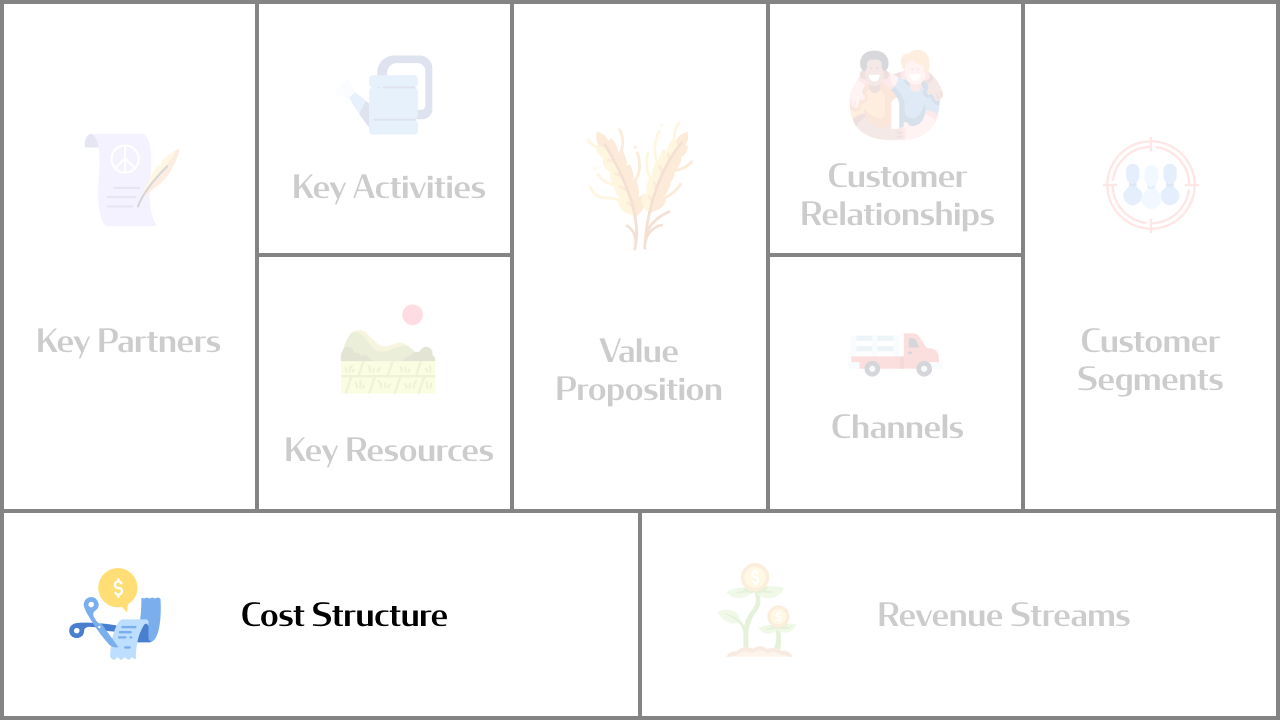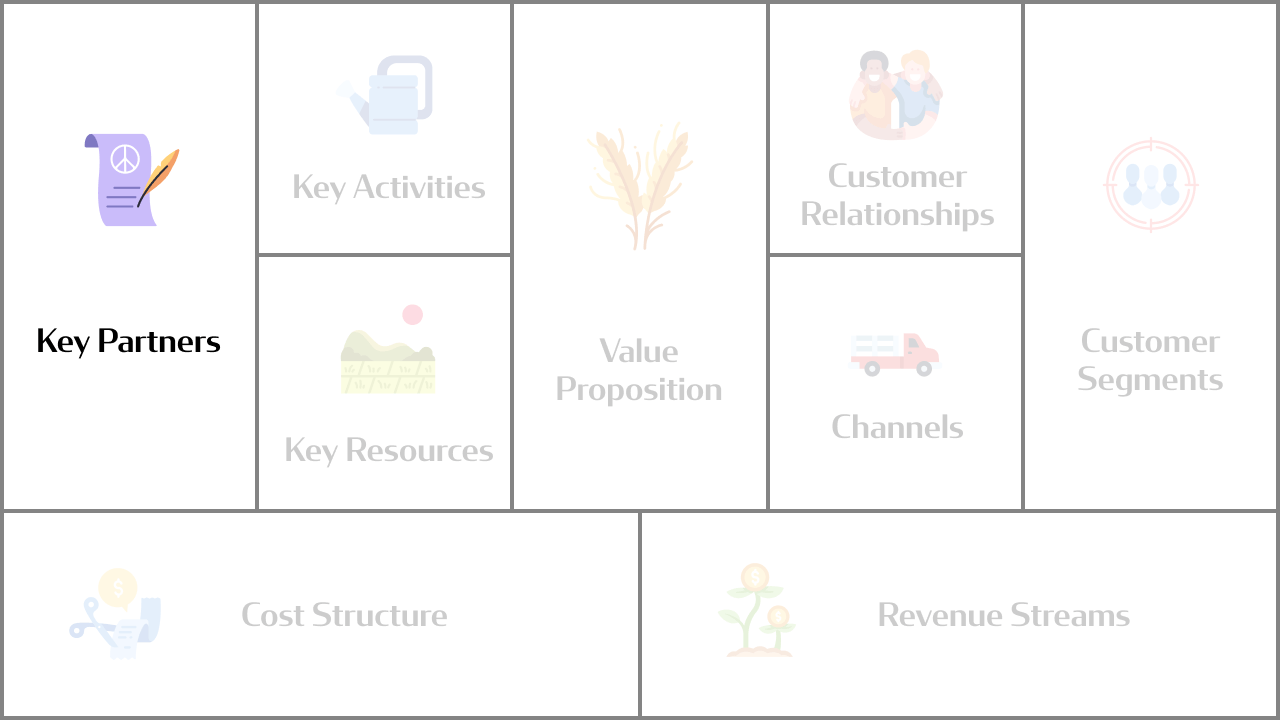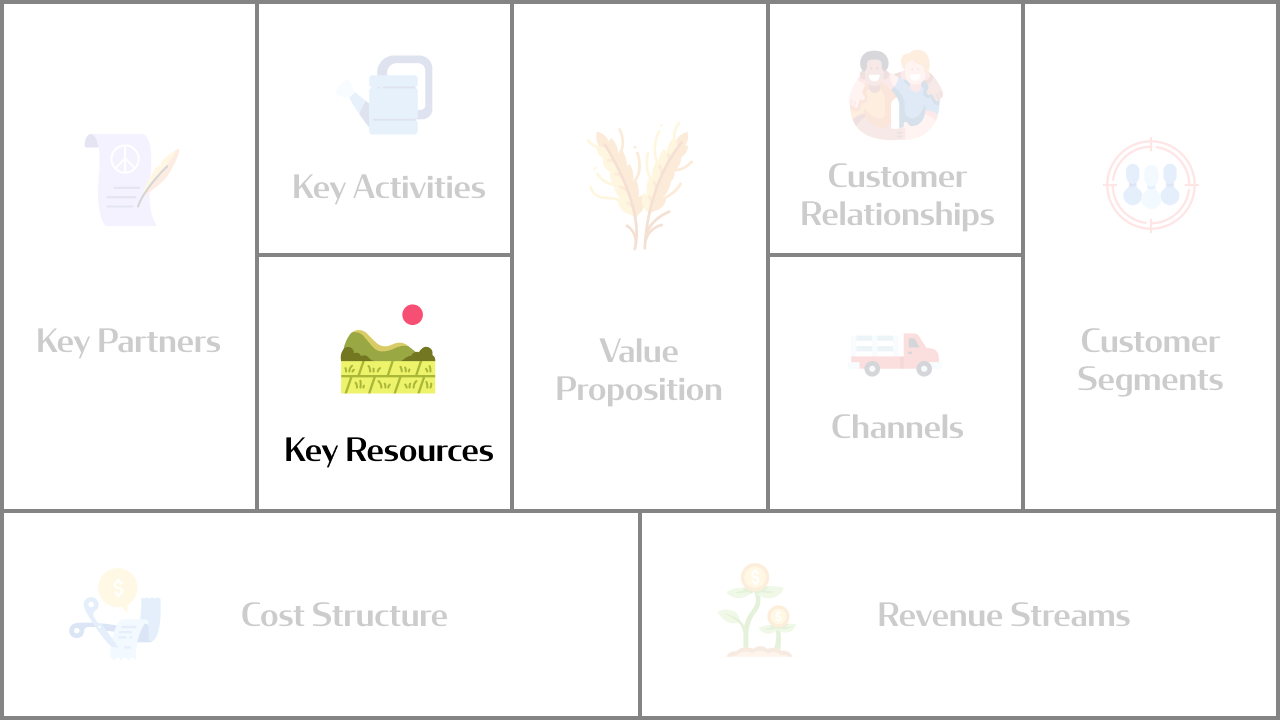eBay is one of the oldest Internet businesses in the world. Founded in 1995, it is one of the few which has remained profitable nearly every quarter since it was formed. It is also one of a very few companies that survived the 2000 “Dot Com Bubble” burst.
In the first quarter of 2021, there will be 187 million eBay users worldwide and a total of 1.7 billion listings on eBay. The company had a revenue of just over $3 billion during this same period.
So how has eBay managed to remain profitable all these years?
Well, one unique aspect of the company is its business model. eBay has focused on allowing individuals or businesses to list new or used items for auction at a meager fee from its inception. When it started, no one else in the industry was doing that.
Let’s look at how eBay managed to turn around a straightforward idea into one of the most profitable business models in the 21st century.

1995-2000: How it all Began – The Birth of eBay
The online auction marketplace environment before eBay
The late 90s were a great time for innovation. The internet was just in its infancy, and everyone was clamoring to get online. Before eBay arrived on the scene, online auctions were between business-to-business or business-to-consumer. Nothing was linking person-to-person interactions except for classified ads in newspapers yard sales and flea markets, which were all offline.
How eBay was born
In 1995 Pierre Omidyar was working as a computer programmer. He had previously worked at Claris, creating software for Apple. His future wife Pam was a collector and trader of Pez candy dispensers. When she complained about the challenges she was having finding people with similar interests, Omidyar got the idea to create an online auction service.
So on Labor Day weekend, he wrote a code for a section of the site that he named AuctionWeb. He wanted the site to become some sort of online middleman between individual buyers and sellers for just about anything. The business plan was simple: offer an online auction marketplace for new and second-hand goods. Once everything was in place, he placed a test listing on the site. It was an ad for a broken laser pointer.
Much to his surprise, he got an immediate offer and a payment of $14.83. Pierre called the customer to confirm whether the client knew that the product was broken. The client admitted that he collected broken laser pointers hence his bid for the item. This was the proof of concept that Pierre needed.
How AuctionWeb Worked
AuctionWeb served the role of a broker; it held no inventory and was not responsible for delivering the items. Sellers simply posted information about their things. Buyers would browse the site according to item category or topic and submit bids via email.
The actual auction was held over three or four days. The bidders would receive email notices when someone made a higher bid, and they could either counter the bid or drop out. The winning buyer would then make arrangements with the seller for delivery details. The payment was processed using paper checks and snail mail.
For the first five months, listing an item on AuctionWeb was free. This attracted a lot of buyers and sellers looking for cheap and rare collectibles and second-hand goods. Word spread, and soon the site garnered a lot of attention. Pierre had to start charging sellers to list their items to offset the cost of upgrading the domain to a business account. Pierre then hired the site’s first employee, Chris Agarpao, to manage the incoming revenue.
From the very beginning, Pierre’s idea was profitable; while bidding was free, it cost sellers between 25 cents and $2 to list an item for sale. There was also a commission of 2.5 to 5% of the sale price sellers had to pay to the site.
Pierre had built an online marketplace community and many people found value in that. By the end of 1995, AuctionWeb was now a multi-million dollar business.
1996: Hiring Help & Expanding
In May 1996, Pierre decided to change the site’s name to Echo Bay Technology Group (eBay) named after Pierre’s consulting firm, and incorporated the company. He quit his job and became CEO, becoming its chief executive. Recognizing that the company needed more business expertise, he went on a hiring spree.
He brought on board Stanford MBA graduate Jeffrey Skoll as eBay’s first President. During that year, eBay received over 15,000 auctions daily, 2,000 new auctions every day, and two million hits weekly.
By the end of the year, eBay had hosted over 250,000 auctions. It had 60 different categories and generated $6 million in revenue, and had six employees. The company also focused on solid branding and creating a flawless user experience. This ensured that they eclipsed the hundreds of upstart auctions sites that mushroomed during the dot-com bubble.
1997: Fighting Fraud & Raising Money
eBay was dominating the online marketplace. In January alone, the site hosted 2 million auctions. By the end of the first quarter, it had sold goods worth more than $10.25 million. One notable sale was an original 1959 “Suburban Shopper” Barbie doll, which sold for $7,999.
This success enabled the company to raise $6.7 million in funding from Benchmark Capital for a 22% stake in the company. Benchmark Capital advised eBay to start targeted advertising which gave eBay an additional 340,000 registered users.
Unfortunately, internet fraud had become a growing concern as more auction sites like Auction Universe and OnSale became popular. Buyers on online marketplaces, including eBay, were paying for goods that never arrived. Moreover, some sites were making false promises for discounted services, and others were charging for internet services that were meant to be free. Between January and October 1997, there were 141 complaints about auction sites.
The complaints reached the U.S. Senate’s Permanent Subcommittee on Investigations, which launched an Internet Fraud watch project in March 1996. The committee conducted hearings looking into Internet commerce challenges and complaints. The major problem was that auction sites like eBay were not liable if the sales went bad. They were just the middleman; the onus was on the two parties to honor their agreement.
The good news for eBay was that they only had 27 disputes out of the millions of transactions in each quarter annually. To counteract the problems found by the Internet Fraud watch project, eBay created a feedback system where buyers could post reviews of their transactions with a particular seller.
Sellers would receive a rating based on the number of successful auctions. Positive comments were worth one point, neutral zero points, and negative comments a minus one. Should a seller have a rating of minus four, eBay would ban them off the site.
eBay closed off the year by securing a partnership with America Online Inc. (AOL). The site became AOL’s exclusive auctioneer and was featured in the hobby and classified prompts pages. In exchange, eBay was paying AOL $12 million over three years.
1998: eBay Goes Public & Faces Competition
Meg Whitman, a Harvard graduate, took over as CEO and President from Skoll. She built a powerful executive team and transformed eBay into more than just a marketplace for collectibles and second-hand goods. It was now a place where you could find just about everything and connected people from all corners of the globe, and in September, eBay went public.
In the first quarter alone, eBay recorded gross merchandise sales of $100 million and revenues of $6 million. The company’s revenue was consistently high during the first quarter because they promoted the auctioning off unwanted Christmas gifts.
Competition for eBay
Business-to-business auction service OnSale Inc. added a similar person-to-person auction option for their users. While this didn’t damage eBay’s bottom line, it was a sign of things to come.
The Los Angeles Times launched a rival site called Auction Universe Inc. to regain lost revenue. Classified ads had become too expensive for low-cost items after eBay arrived. Auction Universe Inc. began advertising city-oriented auction sites using a group of affiliated newspapers, each offering its own local auction site. These websites were mainly aimed at the newspapers’ local areas.
The Auction Universe Inc. had one advantage over eBay. Because it was focusing on local areas, it was easier to auction large items. This cut down the cost of shipping goods across the country as most site users were local.
To counter this move and solidify its position, eBay bought Jump Inc., a developer, and operator of an advertising-supported auction site called Up4Sale. While it did not focus on local area auctions, Jump Inc. had 45,000 items listed in 27,000 separate auctions and 50,000 registered members.
By the end of 1998, eBay was hosting nearly 1.8 million auctions and made over $2.4 million in revenue. Unfortunately, because of its growth and popularity, the users began to expect more from the site.
1999: Ups and Downs
Again eBay had record sales and revenues in the first quarter of 1999. It had $541 million in sales and net revenues of $34 million. It was also during this time that eBay stopped selling guns and ammunition.
There were many ups for the marketplace giant. For example, eBay announced a second public offering. It also inked a four-year $75 million marketing alliance with AOL.
But a seemingly severe threat was looming for eBay. The day before eBay’s secondary offering, Amazon began hosting its own daily auctions although Amazon’s auction site eventually failed, its launch motivated eBay to double its expansion efforts. Despite the competition surfacing from all corners of the web, eBay continued on an upward trajectory most of the year.
In May, it made three strategic acquisitions. It bought Butterfield, a 135-year-old San Francisco auction house, and Kruse International, an automobile auctioneer in Indiana with an impressive amount of popular collector cars.
Why was this strategic? Well, it helped eBay penetrate the high-end market. So far, eBay had been dealing with cheap average goods; if they could get more expensive listings on their site, they would widen their user base. The company noted that such highly-priced goods needed to be presented differently.
eBay began structuring a different site for these goods and called it Great Collections (they would later rename it eBay Premier). The site was launched in October 1999 and partnered with brick-and-mortar auction houses, galleries, and dealers who had their own branded areas on the site. They also offered the same authentication services they did in their physical stores.
The third acquisition was of Billpoint Inc., a California company specializing in internet credit card payments. The aim was for eBay to have smoother payment transactions. Prior to this acquisition almost all auctions on eBay were conducted with paper checks or money orders.
Billpoint was meant to help eBay make closure of auctions faster by allowing buyers to use credit cards to pay for their purchases. Up to that point, only a handful of sellers who had premium merchant accounts with banks could accept credit card payments.
To finance these three purchases, eBay issued $275 million in common stock.
Overseas expansion
At this point, eBay decided to expand its operations. It entered into a joint venture with Australia-based PBL Online this partnership was eBay’s first international venture meant to deliver a localized auction service to Australia. The company also inked an agreement with Collecting Channel to provide its users with more news and information about their collectibles. The first publication was information about Star Wars memorabilia.
The next move was to invade Europe, so eBay acquired Alando de AG, Germany’s largest online trading site. The company has also made plans to add a Japanese-language corner so that 6,500 of its members in Japan could be more comfortable.
Unfortunately, Yahoo beat eBay and launched its own site in September 1999, five months before eBay added its Japanese site. This put a significant dent in eBay’s plans for global expansion.
eBay Website Crash
In June, eBay experienced its first significant challenge. The site experienced numerous crashes while it was a few days away from finishing up installing a backup system. The longest outage was about 22 hours long.
The company had to refund between $3 and $5 million in waived listing fees and made the auctions free for the first time since inception. To avoid another major crash like this, they hired more computer network experts and senior technology managers.
Competitors like Auction Universe Inc. and Amazon reported an increase in traffic to their sites due to eBay’s crash.
eBay had learned that site reliability was paramount and quickly bounced back. By the end of 1999, eBay had 5.6 million registered users and listed over 3.1 million items for sale.
eBay’s Business Model Canvas: The Early Days
At this point, eBay’s Business Model Canvas looked like this:
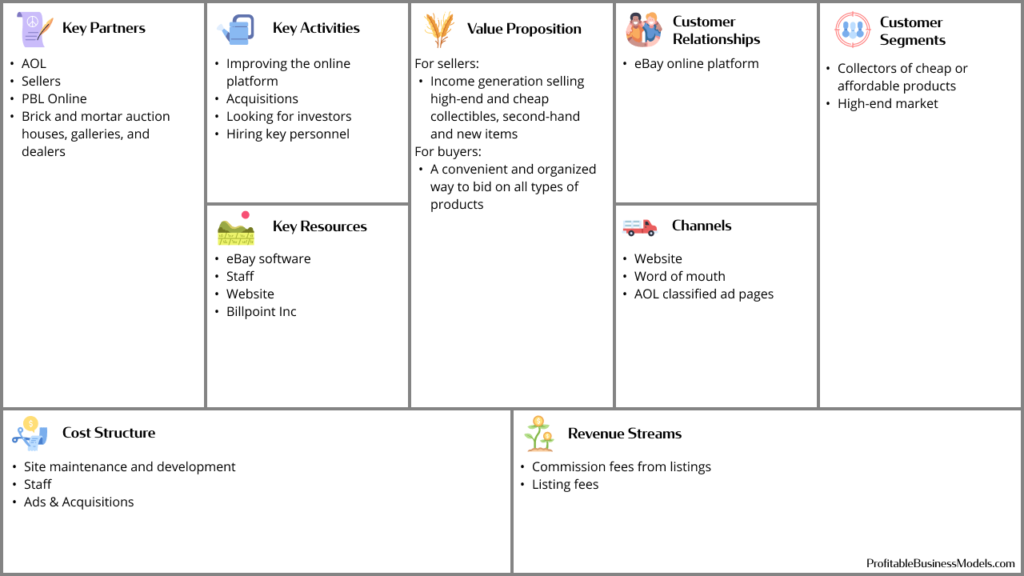
2000-2010: A New Century, The Golden Years
2000: eBay continues expanding
By the new millennium, eBay became the web’s leading auction site. It had ten million registered users and sold around $10 million of merchandise a day. In the second week of January, eBay set a new record by attracting just under 1.8 million users that week.
The company had a cyber-inventory of over 4.5 million items on sale daily. The year saw eBay make several acquisitions; most notably, they bought BusinessExchange. This business-to-business marketplace was aimed at small companies that wanted an easier way to buy office products and equipment.
They also bought Half.com, an auction site that sold used goods for half their original retail price, for $312 million. The site already had four million registered users and earned a 15% commission on every sale.
2001: Strategic Partnerships & Maintaining Dominance
In January, eBay suffered another outage, which lasted 11 hours. Thankfully the outage was minor, and competitors were unable to topple it.
Yahoo, for example, had gained considerable ground and was one of the top three online sites in the world. However, it lost most of its online auction clients after introducing fees in the first quarter of 2001.
Not one to waste an opportunity to retain its dominance, eBay partnered with Microsoft to become the default auction provider listed on Microsoft’s MSN Web sites, such as the bCentral service for small businesses and CarPoint auto-shopping service.
Additionally, this deal was meant to give eBay access to Microsoft’s software programmers, who would then use Microsoft Web-design tools to develop programs and apps for eBay. The aim was to bring eBay’s auctions to mobile devices like pagers and to Web-connected TVs and handheld computers among others.
2002: Purchasing PayPal & Other Partnerships
At the beginning of 2002, eBay partnered with Priceline.com an online travel agency that listed discount rates for travel-related purchases such as airline tickets and hotel stays. eBay wanted to access the travel and leisure market. This service would be part of eBay Travel and allowed users to book flights, hotels, make a car, cruise, and vacation reservations.
The company hoped to attract users who wanted great value for money and a wide selection of travel options, further expanding their customer segment. Next, eBay entered into an agreement with Sotheby’s to market high-end collectibles. This new site would replace the Great Collections (eBay Premier) site.
Lastly, eBay purchased Paypal in a move to improve the payment facilities of its site. This was a natural extension of eBay’s core business and supported the drive to make a more efficient global online marketplace.
Combining Paypal’s functionality into the eBay platform strengthened the user experience. It allowed buyers and sellers to trade with speed and safety. It was a brilliant move, and revenues topped the billion-dollar mark for the first time by the end of the year.
2004-2005: Making & Correcting Mistakes
In 2004 eBay decided to refocus on what it did best; providing a safe and easy online marketplace for buyers and sellers. The Company sold Kruse International and Butterfields (the physical auction houses it had bought in 1999).
They also withdrew from the Japanese market when it was clear that they couldn’t outset Yahoo. Lastly, they phased out Half.com (the auction site that sold used goods for half their original retail price) and replaced Billpoint with Paypal.
In a surprising move, eBay decided to venture a little bit out of its core business again in 2005. They purchased Skype hoping that eBay users would use Skype’s technology to conduct eBay transactions. There was just one problem, eBay users did not want to use video chat to talk to each other. eBay underestimated how vital the element of anonymity was to its users.
2008-2010: Establishing Dominance
Fortunately, this misstep didn’t harm eBay’s bottom line too much. By the end of 2008, the company had worldwide users reaching hundreds of millions. It had 15,000 employees and revenues of almost $7.7 billion. That same year eBay launched its iOS app at Apple’s Worldwide Developers Conference. Finally, in late 2009, eBay offloaded Skype by selling it for $2.75 million.
To attract even more buyers, eBay launched its first-ever rewards program called eBay Bucks in 2010. The program was free and open to all U.S. eBay users giving them 2% back on items bought through the eBay Marketplace using PayPal.
eBay’s Business Model Canvas: The Golden Years
At this point, eBay’s Business Model Canvas looked like this:
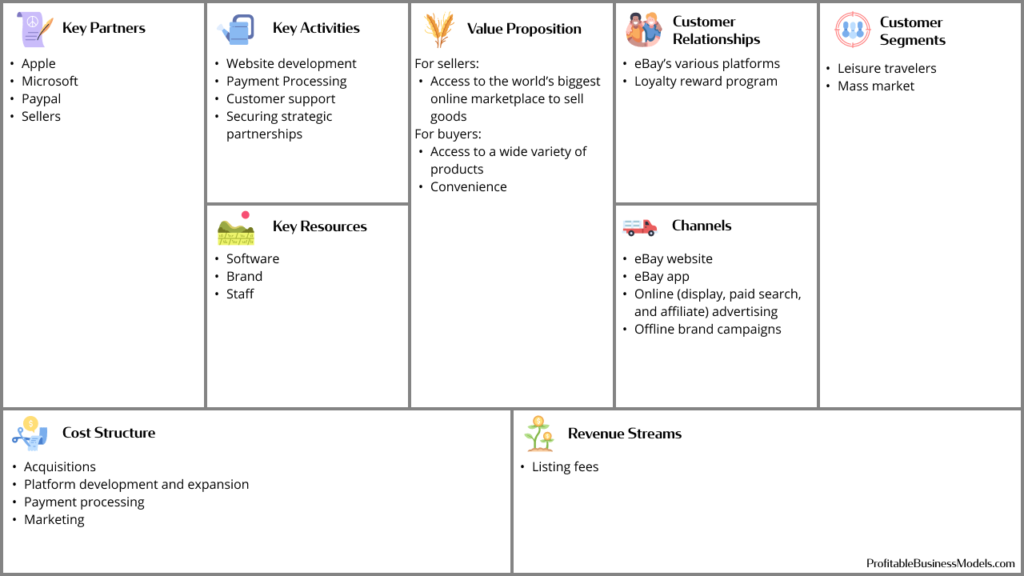
2011-Present: Losing Ground to Amazon
Although eBay continued to make strides, a new rival was gaining in popularity. By 2015 Amazon posed a significant threat to eBay’s dominance. Sellers and merchants were leaving eBay in favor of Amazon because more and more buyers seemed to be migrating to the Amazon marketplace.
There were several reasons for this. Firstly, eBay hadn’t completely solved the internet fraud and security issue that arose in 1997. Amazon was doing a better job of making users feel safer. Secondly, eBay sellers were not guaranteed a free and smooth shipping experience. The company was struggling to convince sellers to provide free or reliable shipping. On the other hand, Amazon was knocking this out of the park, especially when they introduced Amazon Prime and their organized Fulfillment Centers.
Final Thoughts
As of 2021, despite what appears to be steady growth in sales, users, and revenue eBay seems to have lost its place to Amazon as the king of e-commerce. Think about it, when was the last time you remember eBay being referenced in pop culture or everyday conversation?
What started out as a revolutionary and world-changing idea has slowly trickled to the peripheries of relevance in the e-commerce conversation.
Sources
- https://www.oberlo.com/blog/ebay-statistics
- https://www.cleverism.com/company/ebay/
- https://history-computer.com/companies/the-history-of-ebay/
- https://vizologi.com/business-strategy-canvas/ebay-business-model-canvas/
- https://www.ncrypted.net/blog/how-does-ebay-work-insights-into-ebay-business-model/
- https://www.thestreet.com/markets/history-of-ebay
- https://www.cbsnews.com/news/ebay-links-up-with-microsoft/
- https://www.cnet.com/news/ebay-acquires-jump/
- https://www.pcworld.idg.com.au/article/101909/pbl_ebay_build_australian_auction_site/
- https://ir.bookingholdings.com/news-releases/news-release-details/priceline-and-ebay-team-provide-enhanced-travel-services
- https://mwmblog.com/2020/04/22/remember-that-time-ebay-bought-skype/
- https://www.cnet.com/news/billpoint-failure-a-lesson-for-ebay/
- https://sloanreview.mit.edu/article/how-amazon-beat-ebay/
- https://www.forbes.com/sites/barbarathau/2018/05/29/inside-amazons-marketplace-ebay-loses-ground-as-sellers-salivate-over-100-million-prime-members/?sh=54588c1671aa






